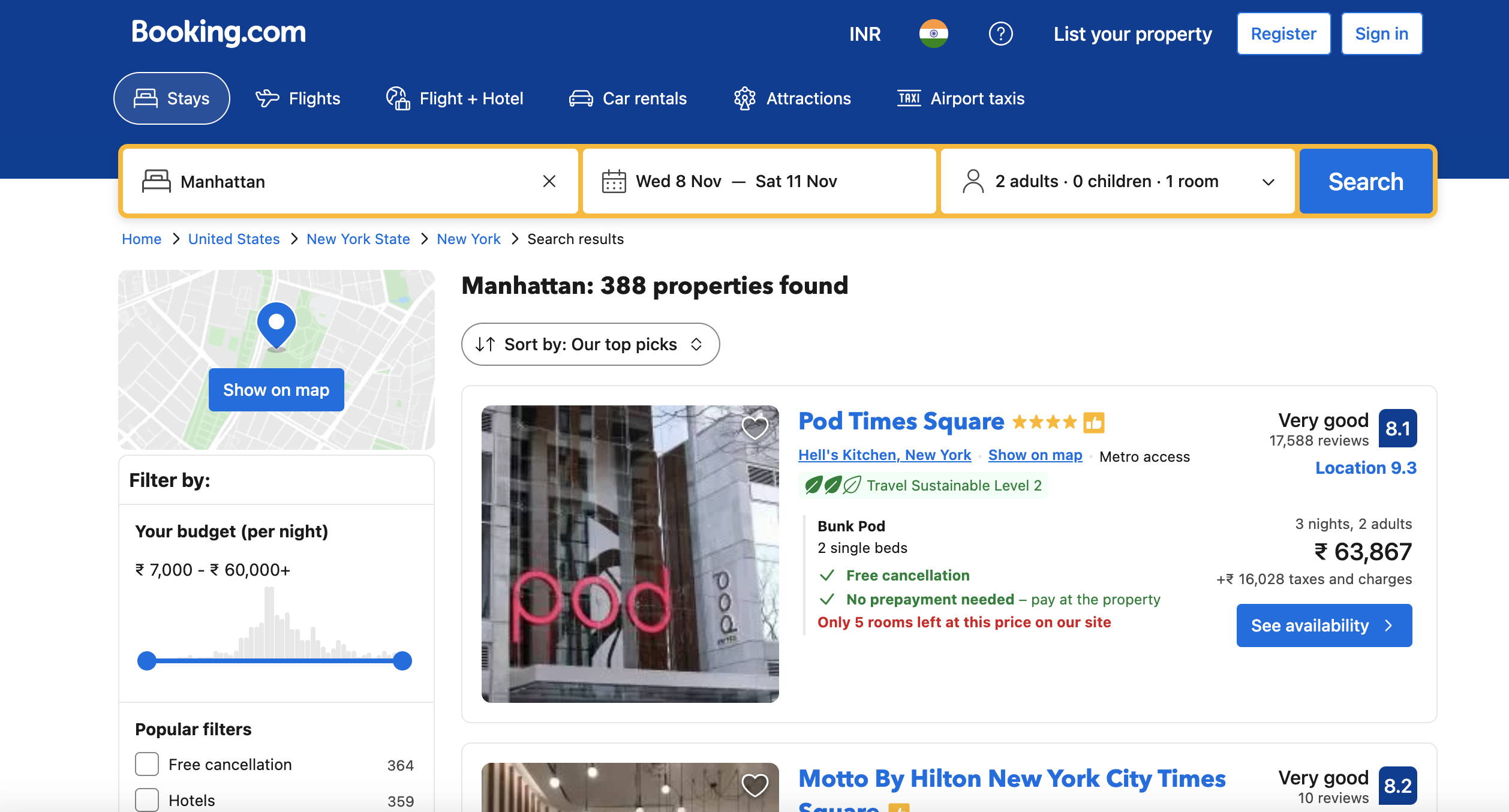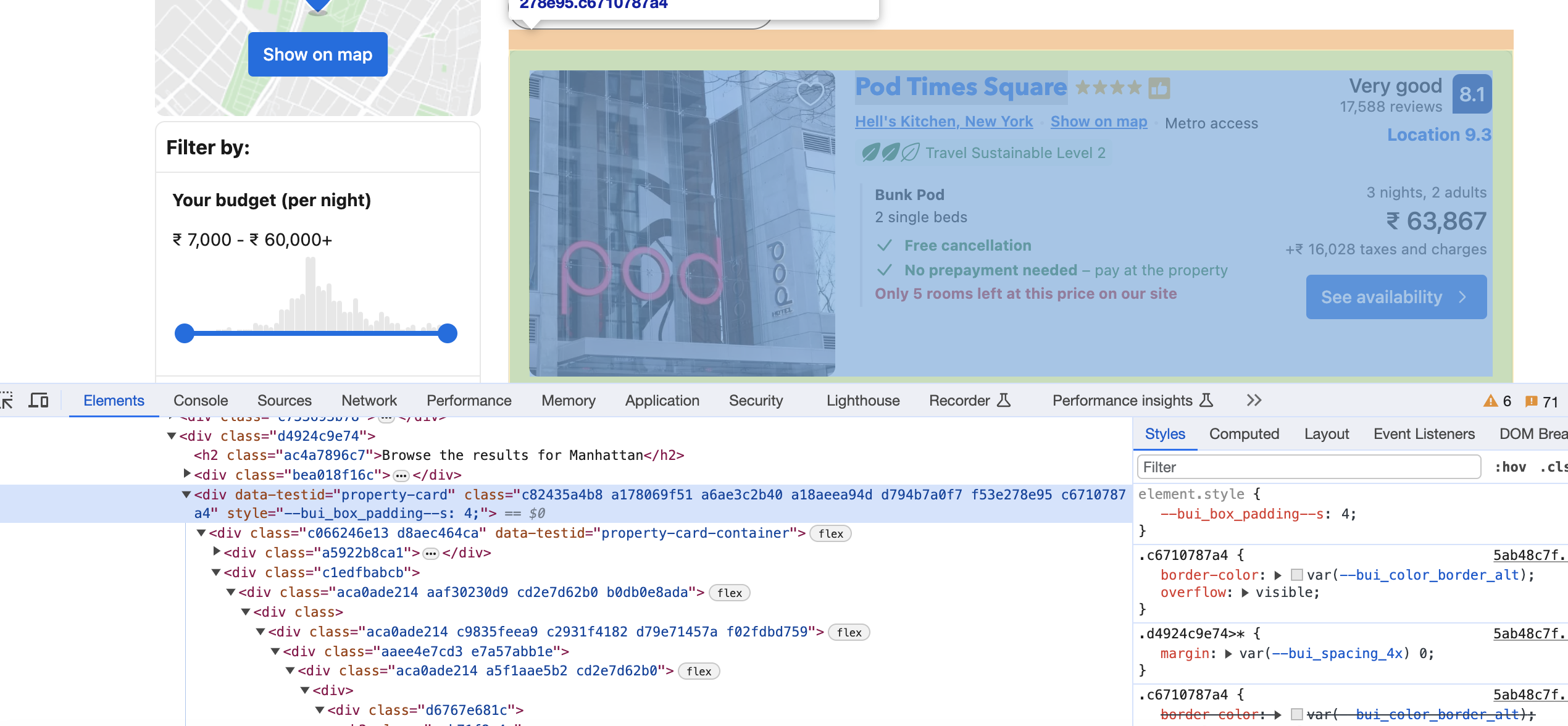In this article, we will learn how to scrape property listings from Booking.com using Scala. We will use Scala libraries like sttp and Scalatags to fetch the HTML content and parse/extract details like property name, location, ratings etc.
Prerequisites
To follow along, you will need:
Adding Dependencies
We will use sttp for sending HTTP requests and Scalatags for parsing HTML.
Add them to
libraryDependencies ++= Seq(
"com.softwaremill.sttp.client" %% "core" % "1.6.6",
"com.lihaoyi" %% "scalatags" % "0.6.7"
)
This will download the packages when building the project.
Importing Libraries
Import the required classes and libraries:
import sttp.client._
import scalatags.Text.all._
Defining the URL

—
Define the target URL to scrape:
val url = "<https://www.booking.com/searchresults.en-gb.html?ss=New+York&checkin=2023-03-01&checkout=2023-03-05&group_adults=2>"
Setting User Agent
Set a valid User Agent header:
val userAgent = "Mozilla/5.0 (Windows NT 10.0; Win64; x64) AppleWebKit/537.36 (KHTML, like Gecko) Chrome/98.0.4758.102 Safari/537.36"
Fetching the Page
Use sttp to send a request and get the response:
val backend = HttpURLConnectionBackend()
val response = basicRequest
.get(uri"$url")
.header("User-Agent", userAgent)
.send(backend)
We configure the backend, headers and send the request.
Parsing the HTML
Load the HTML into a Scalatags tree:
val html = response.body
val page = scalatags.Text(html)
Extracting Cards

Get elements with
val cards = page \\\\ "div" attribute("data-testid" -> "property-card")
This extracts the property card divs.
Processing Each Card
Loop through the cards:
cards.foreach { card =>
// Extract data from card
}
Inside we can extract the details from each
Extracting Title
Get the
val title = (card \\ "h3").text
Extracting Location
Get the address
val location = (card \\ "span" attribute("data-testid" -> "address")).text
Extracting Rating
Get
val rating = (card \\ "div" class "e4755bbd60").attr("aria-label")
Filter by CSS class.
Extracting Review Count
Get text of the
val reviewCount = (card \\ "div" class "abf093bdfe").text
Extracting Description
Get the description div text:
val description = (card \\ "div" class "d7449d770c").text
Printing the Data
Print out the extracted details:
println(s"Name: $title")
println(s"Location: $location")
println(s"Rating: $rating")
println(s"Review Count: $reviewCount")
println(s"Description: $description")
Full Script
Here is the complete scraping script:
import sttp.client._
import scalatags.Text.all._
val url = "<https://www.booking.com/searchresults.en-gb.html?ss=New+York&checkin=2023-03-01&checkout=2023-03-05&group_adults=2>"
val userAgent = "Mozilla/5.0 (Windows NT 10.0; Win64; x64) AppleWebKit/537.36 (KHTML, like Gecko) Chrome/98.0.4758.102 Safari/537.36"
val backend = HttpURLConnectionBackend()
val response = basicRequest
.get(uri"$url")
.header("User-Agent", userAgent)
.send(backend)
val html = response.body
val page = scalatags.Text(html)
val cards = page \\\\ "div" attribute("data-testid" -> "property-card")
cards.foreach { card =>
val title = (card \\ "h3").text
val location = (card \\ "span" attribute("data-testid" -> "address")).text
val rating = (card \\ "div" class "e4755bbd60").attr("aria-label")
val reviewCount = (card \\ "div" class "abf093bdfe").text
val description = (card \\ "div" class "d7449d770c").text
println(s"Name: $title")
println(s"Location: $location")
println(s"Rating: $rating")
println(s"Review Count: $reviewCount")
println(s"Description: $description")
}
This scrapes and extracts key data from Booking.com listings using Scala. The same approach can be used for any website.
While these examples are great for learning, scraping production-level sites can pose challenges like CAPTCHAs, IP blocks, and bot detection. Rotating proxies and automated CAPTCHA solving can help.
Proxies API offers a simple API for rendering pages with built-in proxy rotation, CAPTCHA solving, and evasion of IP blocks. You can fetch rendered pages in any language without configuring browsers or proxies yourself.
This allows scraping at scale without headaches of IP blocks. Proxies API has a free tier to get started. Check out the API and sign up for an API key to supercharge your web scraping.
With the power of Proxies API combined with Python libraries like Beautiful Soup, you can scrape data at scale without getting blocked.